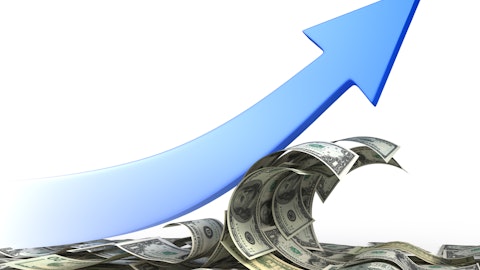And so — but when we think about the recovery and where the markets come back to, certainly, I don’t think — we don’t have a magic ball as it comes to exactly the timing and the magnitude of the recovery, but we do know from past experience that when the market does recover, it can recover pretty quickly and in a very fulsome way.
Tommy McJoynt: Got it. That’s good color. And then my second question, it was really a tough stretch year for any of the business models that are dependent on insurer customer acquisition spend over the past couple of years. Do you have any indication whether or not the competitive landscape has gotten more attractive simply by means of some competitors maybe not making it through or having to tamper down some of their growth expectations? Or do you view most of the competition to be pretty large and scaled players sort of have the capital resources to navigate, so it’s a pretty unchanged competitive landscape?
Steve Yi: Yes. I will say, listen, honestly, I think it’s remained relatively unchanged. We measure our competitive landscape and our market share based on the number of supply partners we have who were in marketplace. And so I mean, in this hard market when really advertisers weren’t spending, we didn’t see really any notable movement in market share, namely any losses of supply partners or gains of major supply partners. In the dry market, as we’ve seen over the last 2.5 to three years, that’s totally to be expected. I think with that said, I think that the players in this space have largely remained. We didn’t see anyone really drop out of the competitive marketplace. And so the competitive landscape hasn’t changed, but we do expect that coming out of this hard market cycle that we’re going to gain market share as we did coming out of the last hard market cycle, simply because we’re the largest marketplace, we’re a marketplace dedicated to carrier spend.
And really, that’s where the recovery is going to happen. And so we do anticipate that we’re going to gain market share vis à vis our competitors and what you’ve seen over the past 2.5 to three years.
Tommy McJoynt: That’s great. Thank you.
Operator: Thank you. Our next question comes from the line of Andrew Kligerman from TD Cowen. Please go ahead.
Andrew Kligerman: Hi. Good evening. Congrats on your persistency in having a great quarter.
Steve Yi: Thanks, Andrew.
Andrew Kligerman: I guess it would be — sure. I mean it’s been a lot of tough quarterly calls, so great to be on this one. But thinking about the cadence of how your revenue might come back, I guess the first question, and the two are intertwined. Do you think — and again, I know you only give quarterly guidance, as Pat says. But looking out to 2025, do you see a potential where you could be at a run rate on transaction value that looks like it can grow on top of 2019-type numbers? And then tied into that question, private versus open transactions. Is this large customer that you’re talking about more geared toward the private market? And so as advertising opens up and more activity occurs, could that come from more open-type business? And could that be a lot higher in margin and profitability than what we’re seeing out of the gate in the first quarter?
Pat Thompson: Great. So Andrew, I can take that. I’ll maybe answer the second question first, actually. It was regarding large customer and kind of gearing to the private marketplace. So yes, that is true. The — we have — I would say a couple of things. One is our P&C business generally has slightly lower take rates than our Health business. And within P&C, P&C tends to be more private than is Health. And our largest advertiser in P&C tends to be more heavily private than the rest of P&C. And so I think kind of given those couple of trends actually, what we’ve seen is the margins stepped down in January, which was we have less Health in January than we did in Q4, and then spend kind of ramped up in January into February. February, the take rates have come down a bit.
And as we’re forecasting March, we think they’re going to come down a bit more, and that’s going to be largely mix driven for us. But in terms of take rate, which we kind of think of as being contribution over transaction value, that number is kind of gently coming down as the market recovers. And that’s probably consistent with some of the trends that you’ve seen over the last few years as we’ve had periods of relative strength. And flipping to your first question, which is what could 2025 be like? And I would just say that we guide to what we have confidence in, which is Q1. And one of the things in my 2-plus years I’ve seen here is that the further out we get, the wider our span of potential outcomes gets. And I think given what we see right now, we’re feeling pretty good about what 2025 could look like.
But it could be better than I’m expecting, worse than I’m expecting, better than you’re expecting, worse than you’re expecting. And so it’s kind of hard to say, and so I don’t want to get into the business of giving hard numbers on that when we just, quite frankly, are focused on executing in Q1 and into Q2 before we talk to you again.
Andrew Kligerman: Very fair, Pat. But just taking that, if I’m assuming a good health growth level, we could see more margin coming from the open transactions, which would be more profitable, again, but that would be my view, not yours. Is that a fair kind of assumption if we see a nice trajectory in growth, more could come from open given that this big account is private?



